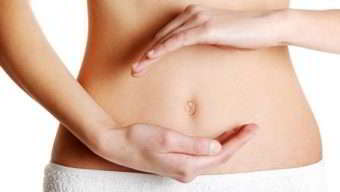
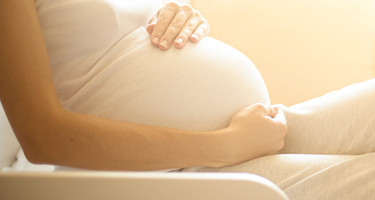
The aim of Intrauterine Insemination (IUI) is to respect the natural environment of the gametes as much as possible, thus favouring fertilisation. This technique consists of depositing a semen sample, which has been prepared in advance in the laboratory, inside the woman’s uterus in order to increase the potential of the spermatozoa and improve the chances of the egg being fertilised.
Intrauterine Insemination (IUI) is a type of fertility treatment that is less complex and minimally invasive. It involves inserting a prepared semen sample, either from a male partner or a donor, directly into the woman’s womb to increase the chances of pregnancy compared to natural conception. The semen sample is washed and processed in the laboratory to ensure only motile sperm capable of fertilising an egg are used. Additionally, IUI can be combined with an ovarian stimulation protocol to regulate follicle growth, and the procedure is carefully timed to coincide with ovulation for optimal results.
IUI is often recommended in cases where there may be no underlying fertility issues, such as for single women doing IUI with donor sperm donor sperm or female same-sex couples. However, it can also be used to treat specific fertility challenges, depending on individual circumstances. Some of these include:
Single women
Heterosexual couples
Female same-sex couples
The typical IUI cycle fee is generally lower than that of IVF treatment, making it a more accessible option for some individuals and couples.
* Live birth rate (LBR) in patients < 35 years old. Based on 2018 data verified by the HFEA.

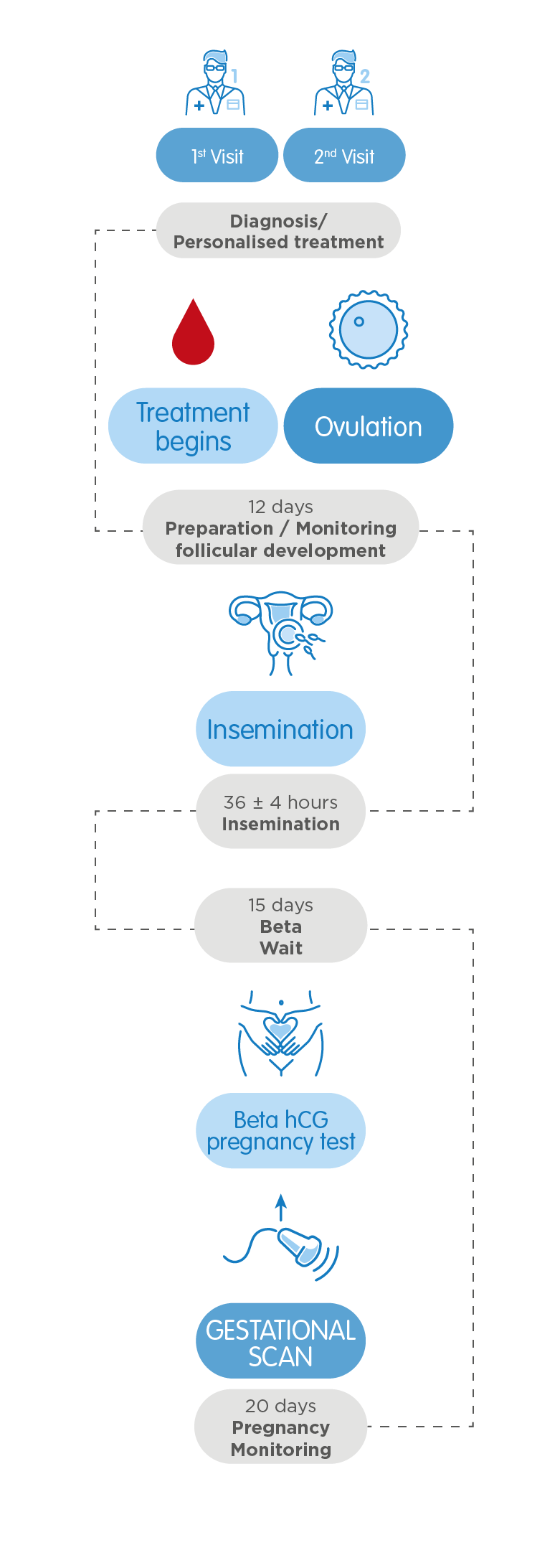

The treatment process starts at the beginning of the woman’s menstrual cycle, at which point ovarian stimulation begins. This lasts between 10 – 12 days.
Ovarian stimulation is optional; however, it can increase the chances of success. As women naturally produce only one egg per menstrual cycle, ovarian stimulation ensures one or two eggs develop. Your consultant will help you decide whether ovarian stimulation is recommended in your specific circumstances.
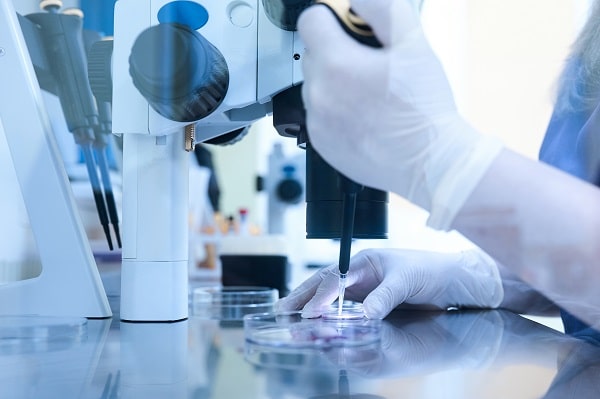
The ovulation cycle is carefully monitored using a series of ultrasound scans and blood tests. Once the follicles have reached the appropriate number and size, a hCG hormone trigger injection may be administered to induce ovulation. The insemination procedure is scheduled 36 hours later.
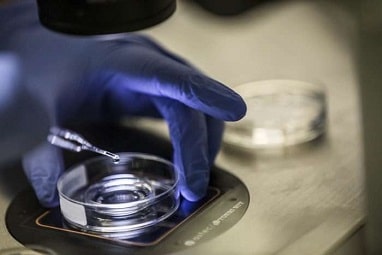
On the day of the insemination procedure, the sperm sample is prepared in the laboratory of your IVI clinic. If the male partner’s sperm is being used, the partner must deposit the sample to the clinic two hours before the procedure is scheduled to take place. This process allows our scientists to select and concentrate the spermatozoa with the best motility and remove immobile or slow-moving spermatozoa, optimising the quality of the sample and increasing the chances of fertilisation.

The insemination procedure is quick and painless. It is performed without sedation or any need for surgery. After inserting a speculum, the semen sample is introduced through a cannula into the uterus. Following the procedure, you will rest for a few minutes. Afterwards, your consultant will arrange with you the date of your blood pregnancy test, which is usually 14 - 15 days after the IUI procedure. At IVI, we recommend that you live life as you normally would during this waiting period, however you should avoid high-intensity or overly strenuous activities.
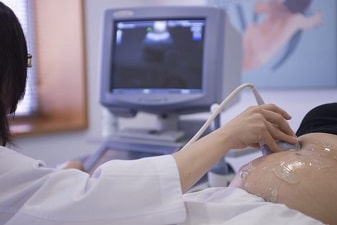
If the result of your blood pregnancy test is positive, a follow-up ultrasound scan is scheduled 20 days later to confirm the pregnancy. Once the pregnancy is confirmed and you have been discharged from your IVI clinic, you can begin your maternity care with your chosen provider.

IUI is a minimally invasive and practically painless procedure. The discomfort can be compared to that of a smear test. You may experience some cramping afterwards, but often what you feel is linked more to ovulation than to the insemination procedure itself. For those considering artificial insemination in London, this gentle approach to IUI in London offers a reassuring and comfortable experience.
It is normally recommended as a treatment for men with sub-optimal or diminished sperm quality. It can also be effective for single women and female same-sex couples. For those considering donor insemination, IUI in London offers a particularly suitable and accessible pathway within the wider fertility treatment journey. It is also a key option for individuals or couples exploring donor conception, where donor sperm may be used to help achieve pregnancy.
Intrauterine Insemination is a method recommended for couples when the following requirements are met:
For single women or female couples, IUI is also an effective treatment option using donor sperm. The requirements will be similar to male factors. A Specialist nurse consultation can help determine whether IUI in London is the most appropriate next step based on individual fertility needs.
The start of the treatment must coincide with the woman’s menstrual cycle. Once established, ovarian stimulation begins (if required). This lasts for approximately 10 days. Once the follicle reaches the right size, ovulation is induced using a trigger injection. The insemination procedure is scheduled 36 hours later. In total, the whole process takes about 12 days.
For those exploring artificial insemination in London, IUI provides a gentle and supportive treatment pathway. It is designed to work in harmony with the natural cycle to give the best possible chance of success. The overall health of the womb plays an important role in achieving optimal outcomes.
An ultrasound scan to confirm there are no structural issues with the uterus or the ovaries which could impact the treatment
A tubal patency test to ensure at least one fallopian tube is functional
Hormonal profile and full serological testing
A semen analysis to assess semen characteristics
Patients undergoing artificial insemination in London will typically undergo these evaluations at a licensed clinic offering IUI in London, ensuring all health and safety standards are met.
The insemination procedure is carried out at the clinic. It is an outpatient procedure that does not involve entering the operating theatre. Once the insemination has been performed, the woman can rest for 15-20 minutes although this has no impact on the chances of success. Once leaving the clinic, they can resume their day as normal.
The cost of Intrauterine Insemination treatment at IVI is £1,200.
You can have an IUI treatment performed at our licensed fertility clinic in London. If you are an IVI Birmingham patient, your consultant will explain your specific treatment for your fertility journey and on which date your procedure in London is scheduled. If you would like to request more information, please contact us.
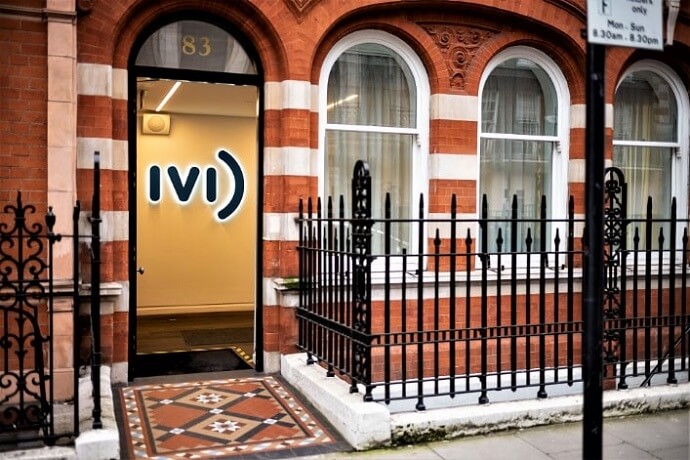

Located within a 10-minute walk from Oxford Circus, the IVI London clinic is a state-of-the-art facility offering a complete range of fertility treatments including IUI, IVF, ICSI and Egg Donation.

